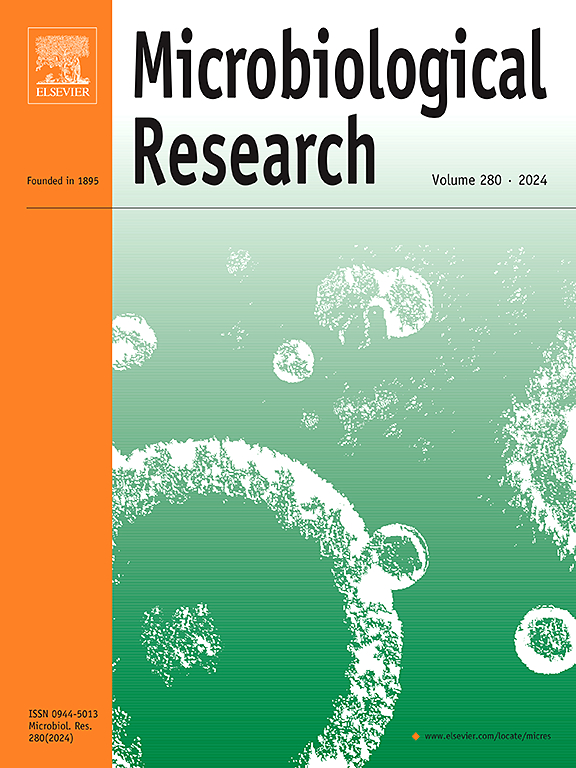IV-A型CRISPR/Cas系统与肺炎克雷伯菌碳青霉烯酶基因质粒传播的关系
IF 6.9
1区 生物学
Q1 MICROBIOLOGY
引用次数: 0
摘要
产碳青霉烯的肺炎克雷伯菌在全球范围内的增加主要归因于碳青霉烯酶基因的质粒介导的传播。IV-A型CRISPR/Cas系统主要位于肺炎克雷伯菌的质粒上,参与质粒竞争。然而,IV-A型系统在肺炎克雷伯菌中碳青霉烯酶基因传播中的作用尚不清楚。在此,我们以152 K为基础,全面研究了IV-A型系统与质粒介导的碳青霉烯酶基因传播的关系。46226 K。NCBI数据库中可获得的肺炎公共基因组。我们发现IV-A型系统的存在与blaNDM-1、blaNDM-5、blaOXA-48和blaVIM-1呈正相关,而与blaKPC-2、blaKPC-3、blaIMP和blaOXA-181呈负相关。此外,携带IV-A型系统的质粒主要是blaNDM-1基因的载体。Protospacer搜索结果显示,IV-A型系统频繁匹配blakpc -2相关IncF质粒的共轭转移区,特别是IncFIB(K)/IncFII(K)、IncFII(pHN7A8)/IncR和IncFIB(pQil)/IncFII(K)质粒。自靶向事件的普遍存在进一步凸显了IV型系统提出的转录抑制的干扰机制。尽管IV-A型系统经常靶向IncF质粒,但不同类型的IncF质粒在crispr阳性和阴性基因组之间表现出不同的分布,从而表明IV-A型系统对IncF质粒的反应存在差异。我们的研究结果强调了IV-A型系统与质粒介导的碳青霉烯酶基因之间的复杂相互作用,揭示了其在形成碳青霉烯酶编码质粒的传播动力学中的重要作用。本文章由计算机程序翻译,如有差异,请以英文原文为准。
Association between Type IV-A CRISPR/Cas system and plasmid-mediated transmission of carbapenemase genes in Klebsiella pneumoniae
The global rise of carbapenem-producing K. pneumoniae is largely attributed to plasmid-mediated transmission of carbapenemase genes. Type IV-A CRISPR/Cas system is mainly located on plasmids in K. pneumoniae and involved in plasmid competition. However, the role of Type IV-A system in the dissemination of carbapenemase genes in K. pneumoniae remains unclear. Here, we comprehensively investigated the relationship between Type IV-A system and plasmid-mediated transmission of carbapenemase genes based on 152 K. pneumoniae clinical strains and 46226 K. pneumoniae public genomes available in NCBI database. We found that the presence of Type IV-A system was positively associated with blaNDM-1, blaNDM-5, blaOXA-48, and blaVIM-1 but negatively related to blaKPC-2, blaKPC-3, blaIMP and blaOXA-181. Additionally, plasmids carrying Type IV-A system were predominantly the vehicles of blaNDM-1 gene. Protospacer search revealed that Type IV-A system frequently matched conjugation transfer region of blaKPC-2-related IncF plasmids, especially IncFIB(K)/IncFII(K), IncFII(pHN7A8)/IncR, and IncFIB(pQil)/IncFII(K) plasmids. The prevalence of self-targeting event further highlighted the interference mechanism of transcriptional repression proposed by Type IV system. Despite frequent targeting of IncF plasmids by Type IV-A system, different types of IncF plasmids displayed varying distribution between CRISPR-positive and -negative genomes, thereby suggesting a differentiated response of Type IV-A system to IncF plasmids. Our results underscore complex interactions between Type IV-A system and plasmid-mediated carbapenemase genes, revealing its significant role in shaping the transmission dynamics of carbapenemase-encoding plasmids.
求助全文
通过发布文献求助,成功后即可免费获取论文全文。
去求助
来源期刊

Microbiological research
生物-微生物学
CiteScore
10.90
自引率
6.00%
发文量
249
审稿时长
29 days
期刊介绍:
Microbiological Research is devoted to publishing reports on prokaryotic and eukaryotic microorganisms such as yeasts, fungi, bacteria, archaea, and protozoa. Research on interactions between pathogenic microorganisms and their environment or hosts are also covered.
 求助内容:
求助内容: 应助结果提醒方式:
应助结果提醒方式:


